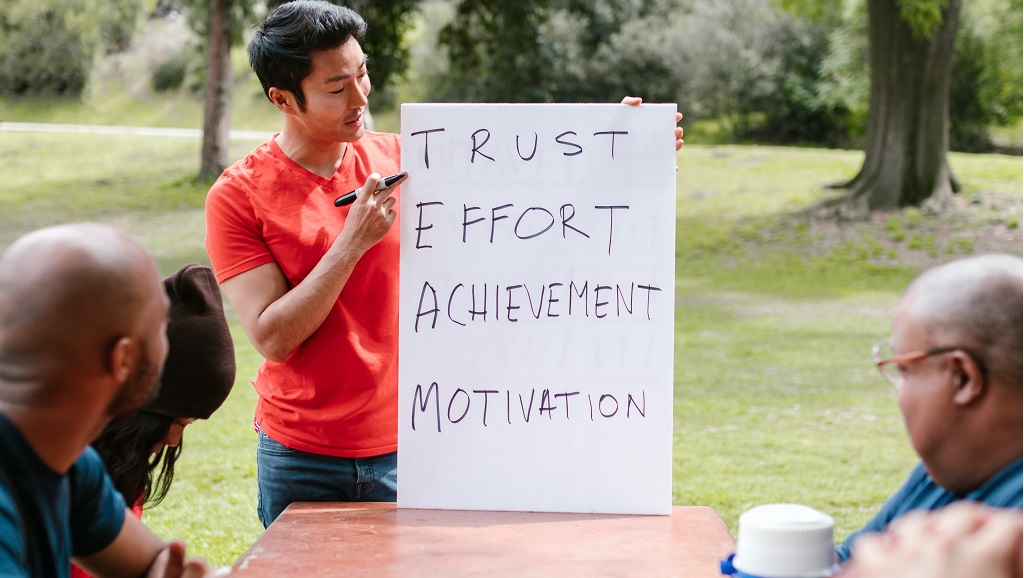No matter which industry you work in, team motivation is absolutely crucial for reaching your ultimate goals. Motivated teams can accomplish so much more, and they have the skills to reach (even surpass) their true potential.
But, few managers are truly effective leaders. Most do not know how to motivate their team. This results in lost revenue, decreased passion, and decreased productivity.
Motivating your team does not have to be a boring or difficult process. With just a few easy steps, you can be on your way to building a motivated team.

In this article, we will discuss a few top strategies for boosting team motivation and why team motivation ideas are so important.
Defining Team Motivation
Team motivation is one of the most crucial aspects of maintaining a successful team. Before you even start thinking of ways to optimize your team’s motivation, you need to know what motivation truly is.
Team motivation is the process of ensuring your team is fulfilled and their jobs feel purposeful. It is a process that boosts your team’s focus on their goals and reminds them of the “why” behind their work.
By focusing on these factors, people become more focused on their jobs. This then leads to sustained efficiency and productivity.
What Does Team Motivation Entail? How Does It Work?
There are several ways you could approach team motivation. Every leader has their own unique strategy, and it is worth exploring your motivation style before committing to one singular technique.

In general, team motivational strategies begin with understanding what employees are passionate about. This means understanding their goals, their needs, and their desires.
From there, leaders meet with employees individually and in a team setting to find ways for employees to reach those goals. They show employees why their role matters for the team and community as a whole.
When times get difficult, great leaders can motivate a demotivated team by reminding them of their goals and values. This can help them stay positive and overcome those challenges to push beyond their limits.
Why Team Motivation is Crucially Important
Team motivation provides so many tremendous benefits to your team. It cannot be ignored. Virtually every aspect of your team’s work will be improved when they are motivated.
For instance, these are a few benefits that come along with increased team motivation:
- Engaging disengaged employees.
- Ensuring your employees stay passionate.
- Building a positive company culture.
- Finding more innovative ways to solve problems.
- Creating better customer experiences.
- Reaching and surpassing your goals, both as an individual and as a company.
- Boosting efficiency and productivity.
The Top 15 Effective Ways to Motivate Your Team Members
Now that you know why motivating your team has many benefits for employees and employers alike, you may be wondering: How do I boost motivation for my team?
Every team is different. They have different values, goals, employees, and resources. While one strategy works best for one team, it may be suboptimal for another.

If you need help finding ways to motivate your employees, consider using some of these 15 effective team motivation strategies:
Be Specific With Your Task Assignments and Goals
As a leader, you will need to be very clear when you set goals for your organization and for individual employees. One way to do this is by using SMART goals: specific, measurable, achievable, relevant, and time-bound.
The same is true of your everyday task assignments. When you are a clear communicator, your employees will be on the same page as you. Thus, they can achieve their goals easier.
Promote a Safe and Positive Workplace Setting
Employees need to feel safe to be themselves. And, authenticity is very important to ensure employees stay productive and happy with their roles.
To promote a safe and positive work environment, you could implement more diversity, equity, and inclusion programs. You could also become more involved in employee wellness and conflict resolution, such as by having consequences for employees who act as bullies.
Give Genuine Feedback Along With Rewards
True, open, and honest feedback can go a long way with any team. Feedback is an amazing opportunity to learn more about oneself, then improve your abilities and grow.
Rewards are important for employees as well. When they accomplish a goal, there should be some form of acknowledgment of their hard work.
Give Ample Opportunities for Personal and Professional Growth
Learning should be a lifelong process. It certainly is with the most motivated teams. By encouraging your team members to invest in themselves, they will have acquired the right toolset to succeed in their work.
Create a Collaborative Workplace Environment
Overly competitive environments often foster negativity and end up hurting productivity rather than boosting it. Instead, you should help your employees stay motivated by providing them with a collaborative workplace.
In such a workplace, employees can feel heard and valued. They are less likely to get overwhelmed or burnt out as well.
Celebrate Successes Along With Your Team
Your employees will likely work very hard to achieve success. One way to ensure they know you appreciate them is by celebrating their successes alongside them.
Consider having a small party or outing with the team after a major accomplishment. You could have a game night together, too. Even simply telling an employee they are valuable can be a great first step.
Limit Inefficient Meetings
Many employees strongly dislike meetings. There are several good reasons to limit compulsory team meetings. They often drain employees. Additionally, there are more efficient and less stressful ways to engage employees.
By limiting meetings, you can give employees more time to focus on what matters: chasing their goals and dreams.
Give Your Employees Ample Acknowledgments of Their Talents
Employees need to know they are valued to stay motivated. To do this, you will have to directly tell them they are valued. Indirectly acknowledge their value, too, such as by giving raises and providing positive feedback on productivity reports.
Allow for Healthy and Friendly Competition
Having an overly competitive workplace can be toxic. However, a healthy amount of competition can encourage individual team members to produce their best work. Healthy competition can boost team morale and improve employee performance.
It can also lead to some comparisons, but if you also have a healthy work environment, team members can help each other while still competing.
Encourage Growth Instead of Dwelling on Failure
Accomplishing goals is a major aspect of any company’s daily work. Each employee has personal goals but must also attain company goals, too. It is important to remind employees that one failure to reach a goal does not make them a failure.
By doing this, employees can become more positive and growth-oriented. They will be less likely to give up and more persistent.
Remind Employees of Their Passions
There needs to be a “why” behind anyone’s work. When times get tough, this reason is often forgotten, which leads to dips in employee engagement.
If you can help employees remember their passions, though, they will be more motivated to continue working even in difficult times.
Encourage Work/Life Balance
Overworking your team members will quickly to employee burnout. When people are burnt out, they are far less likely to stay motivated. On the other hand, individuals with a healthy work/life balance are able to refocus their minds and energy to ensure they can achieve their goals.
Work/life balance is also important for physical health. Employees who are overworked may develop certain health problems, like back pain, which can make staying motivated more difficult.
Work to Reduce Conflicts
Workplace conflicts can seriously drag down the performance of any team. It can significantly dampen even the best employee’s mood. Therefore, as a leader, you need to prevent and manage conflicts effectively.
Be clear about the side effects of having conflicts. Ensure team members work in groups that suit their personalities as well as strengths. Then, when conflict happens, work around it calmly and quickly.
Serve as an Example
When you have a strong sense of motivation, employees will notice that. After all, they look up to their managers and executives as leaders. This will make employees more likely to pick up your positive behaviors, especially after they see your successes.
Give Your Team Members Autonomy
You need to show employees you trust them. If you constantly micromanage employees, they will become demotivated and start second-guessing their abilities.
When you give your team members autonomy, you also give them trust. Since employees like this, it will motivate them to keep producing high-quality work.
How to Ensure Your Team Stays Motivated
Once you get your team to be motivated, you need to ensure they keep that level of enthusiasm for a long time. There are numerous ways you can boost motivation for both the long and short term.
You need to be clear with your goals, foster collaboration, and ensure employees work in a positive environment. This needs to continue for the long term.
If your team only stays positive or gets a work/life balance for a portion of the year, they will not maintain motivation consistently. Remember, when it comes to motivation, consistency is key.
Current and Future Motivation
You will need to ensure your team is motivated both right now and for many years to come. To do this, you need to ensure you listen to your team and take their feedback on your motivating strategies.
This will allow you to learn what helps your team best. In the long term, this will help them the most. Continue to use the strategies that work now and in the future.
As your team changes, though, experiment with some new strategies as well. Learn about your team’s strengths and weaknesses to see what type of motivation works best for them.
Things to Avoid When Trying to Motivate Your Team
Even if you have great intentions, there are some motivational approaches that you should avoid if you want to maximize positivity and motivation on your team. Your communication and leadership strategy may also hold your team back.
You should refrain from comparing your employees to one another, as this could cause resentment and unhealthy competition. In addition to this, you should not lie to your team or give them “fake compliments” since they will value your input less if you do this.
Another thing you should avoid is downplaying the sacrifices your employees have made, calling them lazy, or otherwise insulting them. While you may think this could motivate them to overcome their weaknesses, it will simply make them negative and unhappy.
Different Types of Motivation for Teams
While many view motivation as one overarching strategy or end goal, there are actually numerous different types of motivation. You need to master each of these motivational types to truly make your team as motivated as possible.
Below, we describe the two main forms of motivation and the differences between them.
Intrinsic Motivation
Intrinsic motivation is a type of motivation that stems from within the employee. It is a satisfaction that comes internally from accomplishing the employee’s personal goals.
Most if the time, there are emotional reasons that empower someone to continue working in a certain career. These reasons may not be known to anyone except for that individual. They will then use those motivators as reminders themselves.
Intrinsic motivation comes from the self. You do not rely on others for intrinsic motivation.
Extrinsic Motivation
Extrinsic motivation is a form of motivation that focuses on outside rewards and communication. Forms of extrinsic motivation can include pay raises, boosts in grades, and increased social status.
Extrinsic motivation can also include being motivated to avoid punishment. For instance, if an employee knows they will be fired without completing a certain project, they may be more motivated to complete it.
We previously mentioned intrinsic motivation comes from within. On the other hand, extrinsic motivation comes from others.
Forms of Motivation Within Teams
So, motivation can be separated into two main types — intrinsic and extrinsic. But, there are even more different subcategories of motivation found within teams.
A few of these distinct motivation types are:
Motivation by Affiliation
Many individuals feel a very strong connection to their teams. This affiliation makes employees motivated to work hard, since they do not want to let their team down.
Affiliation motivation can also come from belonging to a certain non-work group. If someone believes they must work hard to provide for their spouse or children, this is also affiliation motivation.
Motivation by Competence
People have an innate desire to show others they are valuable and skilled. Competence motivation is about demonstrating your worth to your team and the deep desire to feel competent.
Many employees often feel like they are not good enough to work for their team, and competence motivation can help combat that. It gives employees much-needed confidence.
Motivation by Achievement
Achievement motivation can be very potent and powerful. When individuals work very hard to achieve their goals, they often get immensely happy to see the rewards of their efforts.
As a result, when their achievements can serve as reminders to keep pushing even when things get tough.
Motivation by Incentive
Incentives can be a huge motivating factor in nearly any workplace. Perhaps one of the most common motivating incentives is money or pay raises. Other forms of incentives include extra days off, recognition, or more opportunities.
Boosting Management Motivation
You may think that only employees need to find which form of motivation suites them best. The truth is that everyone benefits from learning about their motivational style, even managers.
Many of the tips that apply to employees also apply to managers. You need to ensure you have a great (or at the very least, satisfactory) work/life balance, remind yourself of your passion for your job, and listen to input from others.
When you feel unmotivated or disengaged as a manager, look back to your employees and realize how meaningful your job is. Note all the people that depend on you.
Finally, you should explore which particular type of motivation works best for you. Are you more motivated by incentives, such as climbing up the corporate ladder? Or, is affiliation motivation more effective?
Regardless, knowing your motivational style will help you stay motivated for the long-term.
FAQ About Team Motivation
What should I tell my team to inspire them?
You need to understand what inspires your team. Learn about their passions and individual goals. That way, your inspirational pep-talks can truly be inspirational.
Remind your team why they do the work they do. Show them the impact they have on the world and on your local community. This will most likely serve as great motivation for them.
What are some quotes that can motivate a team?
Every team gets motivated in a different way. A few quotes you could tell your team include the following:
“Teamwork is the fuel that allows common people to produce uncommon results.” – Andrew Carnegie.
“My great concern is not whether you have failed, but whether you are content with your failure.” – Abraham Lincoln.
“Teamwork is so important that it is virtually impossible for you to reach the heights of your capabilities or make the money that you want without becoming very good at it.” – Brian Tracy.
How can I motivate my team with words?
You can motivate your team effectively by understanding their unique goals and passions. Then, you can remind your team of these passions and their impact on the organization, community, and world.
You could say something like: “This team depends on you. Without you, we could have never produced such an incredible marketing campaign.” Or, you could say: “You are saving so many lives by helping us build this product. So many people are eternally grateful to you.”
What are some ways to motivate an unmotivated team?
Most teams go through periods of time where motivation dips. When this happens, it is your job as a leader to motivate them again.
One way you could go about doing this is through reminding your team of their impact on the world. Help them meet and surpass their personal goals. Give team members ample amounts of break and mitigate conflict as well.
Conclusion
As a leader, it is you job to ensure your team stays motivated. The most motivated teams are also often the happiest, most passionate, most committed, and extremely productive.
By investing in your team’s motivation, you can improve virtually every aspect of your career.
From small tasks like compliments to more major changes like shifting company culture in a positive direction, your decision to focus on motivation will lead to immense benefits in the future.


